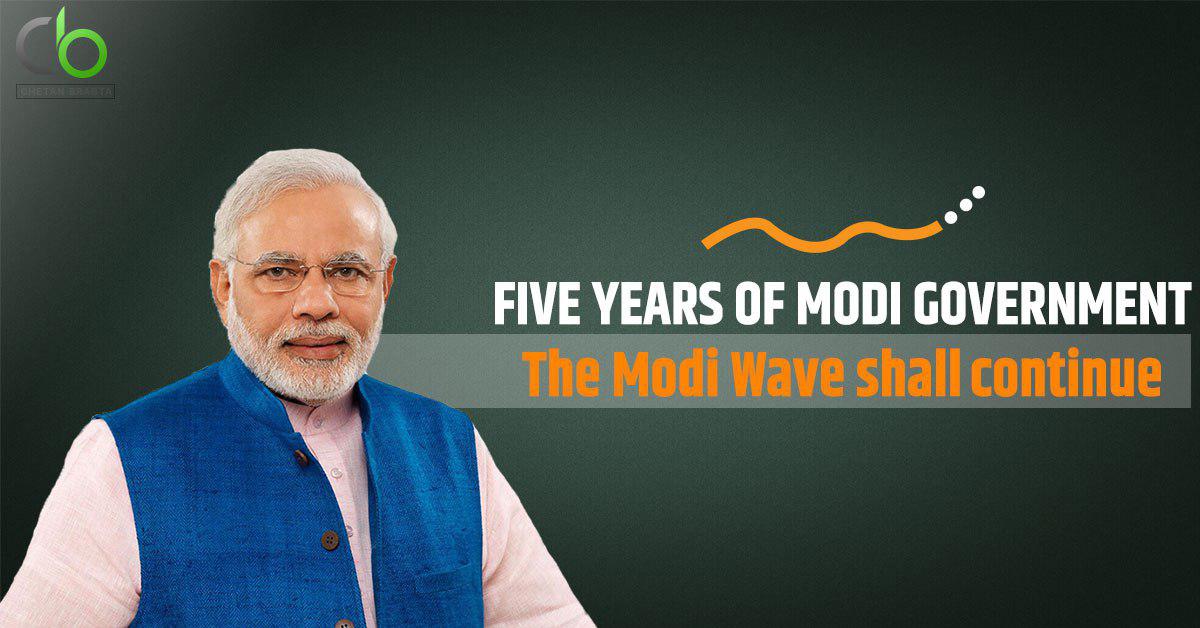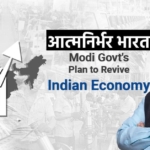
Before 2014 elections, Modi Ji had made a place for himself with his vision and activities that he had done for Gujarat’s welfare. After BJP’s success in election, Modi Ji shared his vision & made promises of welfare & success to the people of India. Since then, Modi Ji had made an everlasting impression on people with hard work & dedication towards the nation. He is determined to change India, by fulfilling his commitments despite of hectic schedules, this determination has helped him produce and execute ideas & schemes for the welfare of customers. He has succeeded with regards to broadening and extending his support base, and in communicating the fundamentals of his vision of a responsible government.
Achievements of Modi government
- Economy and Finance : The period 2014-19 has witnessed the fastest ever growth in the GDP i.e. 7.7 as compared to 6.7 which was the GDP for the period 2009-2014. It has been a period of fiscal consolidation. The growth of real capita GDP (per cent) has been 6.2 for the year 2014-2019 while it was just 5 till the year 2014. Inflation has been broadly under control, the inflation ranging to 10.1 before 2014 is now close to 2.7 per cent. Also, National Democratic Alliance (NDA) government, per capita income has grown 45 per cent, from 2014-15 to 2018-19. In 2014-15, an average Indian earned Rs 86,647 per year. If we talk about Foreign exchange reserve, India’s foreign exchange reserves were US$ 393.29 billion in the week up to December 21, 2018, according to data from the RBI. India’s Foreign Direct Investment (FDI) equity inflows reached US$ 389.60 billion between April 2000 and June 2018, with maximum contribution from services, computer software and hardware, telecommunications, construction, trading and automobiles. The fiscal deficit from the year 2009-2014 was 5.4 but since the time Modi government has taken control the deficit now accounts to only 3.7 per cent. The current account deficit percent of GDP is just 1.5 whereas it was 3.3 percent from the year 2009-2014. Moreover, the external debt end period – percent of GDP has decreased from 23.9 to 20.0. Not just stopping to this, the Modi government has taken the largest ever financial inclusion scheme in the world i.e. Pradhan Mantri Jan Dhan Yojana under which about 35 crore bank accounts have been opened connecting every household to the banking system.
- Goods and Service Tax: Elimination of multiple threshold limits under earlier laws (15 million, 2 million and 1 million Indian rupees under the central excise, service tax and state VAT respectively), and of hundreds of general and thematic exemptions, has broadened the tax base. In one year, GST has already seen the number of registered taxpayers jumping to over 11.2 million, from 6.4 million under the earlier tax regime: a 40 percent increase in the number of taxpayers. During the first nine months, from July 2017 to March 2018, monthly average GST collection of 890 billion Indian rupees ($13 billion) yielded a revenue growth of 11.9 percent; i.e. a tax buoyancy of 1.22, which has historically been achieved very rarely for indirect taxes. In the first three months of this fiscal year, from April to June 2018, the monthly average GST collection rose to 975 billion Indian rupees, showing continued buoyancy. GST will strengthen the country’s tax base for the medium term, adding up to an additional 1.5 percentage points of GDP.
- Infrastructure: When we talk of infrastructure, Modi government has managed better than virtually every other previous government. Be it roads or ports, rivers or railways, aviation or even power, all the sectors have undergone improvement. Rural roads were built in 2013-14 at 69 km per day. It has increased to 134 km per day in 2017-18. India has become the largest Highway developer in the world. The similar is the position with the National Highways, where today 25 km per day i.e. more than 10,000 km a year are being constructed. Currently the Metro service functions in 14 cities and its length is 645 km. India’s first High Speed Rail will be completed in 2022-23 covering a distance of 500 km between Ahmedabad and Mumbai. India’s air traffic in the last four years has seen the largest ever growth. Today we have 102 functional airports. We have moved towards near total rural electrification. Under the former government, lots of developments were being assigned; money was being spent, while nothing major happened on the ground for years and years. But, I see a complete opposite action in the present government.
- Inflation: Inflation during the period 2009-14 was 10% plus. During the period 2014-19, it will come down to an average of about 4.5%. In fact, the last three years average is much lower. Presently it is close to 2.7 per cent.
- Defence: While we talk about defence, we are concerned about center security, our global strength and the well-being of the armed forces. One Rank One Pension(OROP) was a colossal issue and one of the greatest difficulties for the government of Narendra Modi. It was an issue concerning lakhs of ex-servicemen who watched the country without dread or support. The Defense Ministry had its assignment removed and it figured out how to determine the issue. Status Report on implementation of OROP benefits as on 30.09.2017 and compiled up to 31.12.2017 As per the reports received from the CGDA, a sum of Rs. 4,161.45 crores, Rs. 2,397.22 crores, Rs. 2,320.7 crores and Rs. 1,859.72 crores have been paid towards first, second, third and fourth installment of OROP arrears respectively. 20, 43,354 Ex-Servicemen/family pensioners, 15, 94,063 Ex Service men, 15, 71,744 Ex-Servicemen and 13, 28,313 Ex-Servicemen are the beneficiaries during these four instalments respectively. Total arrears paid Rs. 10,739.09 crores. The ministry says that the issue was resolved after four years and the decision announced by Prime Minister Narendra Modi.
- The Insolvency and Bankruptcy Code: It is assessed that in the last two years about three lakh crore of NPAs have been recovered on account of enactment of IBC either through the IBC process or through the pre-IBC provisions. The capability of banks to support growth has enlarged. The amalgamation of banks is giving way for stronger lending institutions.
- Some Social indicators: The LPG coverage across the nation was 55 per cent in December, 2014 and had increased to 93 per cent (as on 8.3.2019). Ayushman Bharat has provided hospital healthcare to 10.74 crore families adding up about fifty crore beneficiaries. Rural sanitation has increased from 39 per cent in 2014 to 99 per cent as of today.
- Employment: The ongoing study of MSME distributed by the Confederation of Indian Industry in the long stretch of March, 2019 spreads 105,345 firms of differing sizes, crosswise over divisions and topographies. The survey specifies “a development of 13.9 percent in Net Jobs Created in the course of the most recent 4 years at 3.3 percent per annum (compounded growth rate).” The study further states “given that the all-out the total workforce size according to the Labor Bureau is estimated at 450 million (anticipated for 2017-18), the overall job additions work out to 13.5 – 14.9 million per annum.” The above fits in with the patterns given by the EPFO information by S.K. Ghosh and Pulak Ghosh. EPFO information demonstrates that 72.32 lakh new subscribers were added to EPFO between September, 2017 and December, 2018. This would not be possible without an expansion in employments in the formal division. This is supported by an examination by Mohandas Pai, which determined that 1.08 crore employments have been made in only three callings – CAs, Lawyers and Doctors in 2017. The faster pace of constructions of National Highways and rural roads under PMGSY are evaluated to have produced 178.8 crore individual – days of work (according to an IIT, Kanpur Study). New partakers in the online business and innovation space like Uber, Ola, OYO and so on have produced many direct & indirect jobs. About Rs.7.99 lakh crore have been endorsed under MUDRA, out of which 28% loans are provided to new entrepreneurs.
- Fighting Corruption: The BJP government assured to create a system, which eradicates the possibility for corruption, encourages technology-enabled e-governance, minimizing the decision in the citizen-government interface. The Narendra Modi government has scored well on these promises. There has been no corruption charge against the ministers of the government. Scams in the distribution of government contracts have not been reported since Modi government. E-auctioning has been implemented.
What will Modi government achieve in next 5 years?
Modi Waves is set to continue as Modi ji will definitely win 2019 elections because he has flourished in changing lives of people by improving the conditions of living. Alos, Modi government vows to standard the minimized and acquires a more prominent feeling of responsibility among the privileged and the powerful has not been simple claptrap. His ideology of New India depends on engaging the bases, making the system responsible, conquering any hindrance between sections, enlarging the domain of incorporation, and speaking to the civilizational power of a individuals who had, in the past, exhibited a dynamic spirit and ability of entrepreneurship.
Modi government in next 5 years will be assuring that the every family with a pucca house, water connection, toilet and 24×7 electricity supply; increasing proportion of formally skilled labor from 5.4% of workforce to 15%; expanding the share of freight transported by coastal shipping and inland waterways; expanding the length of national highways; and setting up an independent regulator for the Indian Railways.


में भी चौकीदार हु मोदी है तो मुमकिन है नमो नमो
मोदी हैं तो मुमकीन हैं
मोदी देश को उज्ज्वल भविष्य की ओर ले कर जाएगा।
राहुल देश के टुकड़े करके
देश को बर्बाद करने पर तुला है